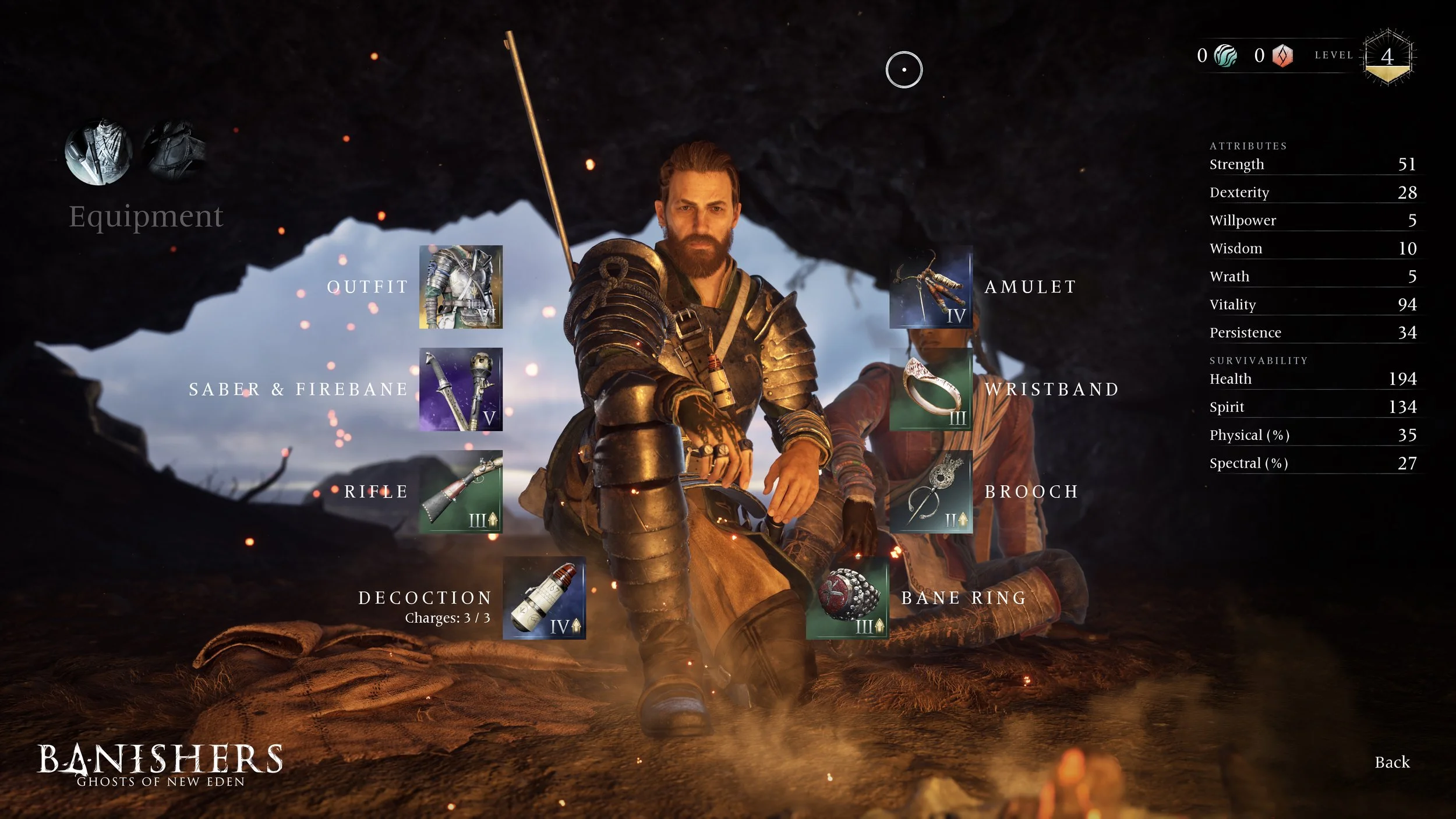Banishers: Ghosts of New Eden [Review]
Banishers is a heartbreaking New England Colonial Ghostbusters where your choices matter.
Banishers: Ghosts of New Eden. Credit: Don’t Not / Focus Entertainment
Don’t Nod’s action RPG Banishers: Ghosts of New Eden features the kind of captivating story I’ve come to expect from the studio’s games. It’s a well-written drama with deeply compelling characters and real stakes, told in blockbuster AAA style. Banishers also features Don’t Nod’s best action gameplay to date.
The game takes place in New Eden, a British colony in the American northeast, in 1695. Banishers Antea Duarte and her apprentice and lover Red mac Raith arrive at the colony, hired to help lift a curse that’s been plaguing the community. Banishers are essentially ancient Ghostbusters; they use tools, rituals, and magics passed through their order to solve hauntings, to “banish” ghosts that won’t leave the mortal realm and torment from the living. Their attempt to exorcize the powerful ghost causing the curse ends in disaster, killing Antea in the process. Red barely survives and discovers that Antea’s ghost hasn’t moved on. With her help, he must now vanquish the ghost that haunts New Eden and lift the curse. Along the way, they solve other haunting cases plaguing the inhabitants of New Eden, making decisions that will deeply affect the community and the outcome of the story.
Banishers: Ghosts of New Eden. Credit: Don’t Not / Focus Entertainment
You’ll spend a large part of your time playing Banishers in combat. Gameplay here feels a lot like a more fluid Bloodborne, with blocking, parrying, and shooting as a crucial means of survival. The twist is that you can tag-team between Red and Antea, a human and a ghost, to use their different abilities and strengths to your advantage. Upgrades through a skill tree and your choice of weapon, armor, and charms let you tune your build to best fit your fighting style. Combat feels great, especially when you find a build that works for you and learn to parry and combo effectively. I spent a lot of time finding and completing the various bonus combat challenges spread throughout the game’s open world.
Even though there’s a lot of combat, the real heart of Banishers is a series of detective mysteries. In order to solve hauntings, you first need to investigate. You need to find evidence of a haunting, discover who the ghost is, find an object that ties the ghost to the victim, and the reasons why the victim may be haunted. Red and Antea do this by interviewing witnesses or the people involved, investigating scenes for clues, following ghostly trails, watching echoes of the past, and more. Once you’ve found all the information you need, it’s up to you to decide how you resolve the haunting. You must make a moral choice, whether to banish the ghost to the void, help the ghost ascend, or blame the living victim, sentencing to death a person who may not be the victim after all.
Banishers: Ghosts of New Eden. Credit: Don’t Not / Focus Entertainment
These investigation stories surrounding the game’s main conflict is where the very human drama of the game plays out. The personalities of the people involved, the results, and the effects of your decisions on the world, Red, and Antea are what makes the game so compelling. Most of the hauntings in the game are optional to find and solve, but it’s something I very much recommend doing if you’re going to play.
Driving those investigations, as well as everything else, is the stellar writing of the game’s script. There’s a ton of dialogue in Banishers and none of it is tedious, long-winded, or boring. Characters have unique voices and personalities, and their dialogue is nuanced and mature. Part of what makes this work is also the voice cast’s stellar performances all around. I rarely found myself reading ahead and skipping the vocal performances. I’ll admit that I didn’t read a lot of the notes and documents you find scattered as collectibles in much detail, but that’s not what shines here.
Banishers: Ghosts of New Eden. Credit: Don’t Not / Focus Entertainment
Banishers has a crafting system for weapon and gear upgrades that I could take or leave. It gates upgrades behind availability of resources that appear as you progress, but frankly it’s unnecessary. It’s a little irritating hunting for the plants and other materials as you run around the world. Likewise, there’s a series of sidequests involving finding locations based on treasure maps, sketches, or other clues, that I found tedious as well. These are minor complaints about an otherwise really excellent game.
Visually, the game is beautiful. It’s full of lush environments and character models are detailed and expressive. The lighting and color are gorgeous in HDR on my PS5. My only quibble with the game graphically is that I wish that there was a little more variety in enemies and that their looks were more differentiated, though this doesn’t extend to the game’s bosses—those are great. The rich soundscapes also help make the game suitably spooky when it needs to be.
Banishers: Ghosts of New Eden. Credit: Don’t Not / Focus Entertainment
I highly recommend Banishers: Ghosts of New Eden. The game didn’t get talked about enough when it was released and is definitely worth your attention. Though the combat in the game is great, it’s not very unique, which could be a reason why the game didn’t make as much of an impression as it should have. The game’s story has made Banishers one of the most memorable games of the year for me so far.
Banishers: Ghosts of New Eden is available on PC (Steam / Humble / Epic), PlayStation 5, and Xbox Series X|S.
Overall Score: 9/10
Played on: PS5


